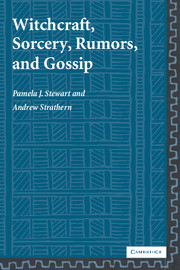7 - Rumors and Violence
Published online by Cambridge University Press: 20 November 2009
Summary
Rumors and gossip are often crucially involved in the genesis of overt violence in communal settings, sometimes taking the form of suggestions that covert violence is being practiced through witchcraft, sorcery, or other forms of ritual. Alternatively, rumors may take the form of protests against what is perceived as the imposition of violence by state authorities. These protests in turn can generate active and violent resistance movements. Rumors of atrocities often form a part of this overall process. Here we take the case of rumors of construction sacrifices in Indonesia to illustrate this point, setting these rumors into the overall regional literature on head-hunting (Stewart and Strathern 1998c). Violence against outsiders is easily generated by rumors also and these therefore invariably play a part in intergroup conflicts along ethnic and/or religious lines.
As we have seen in the materials presented from Africa (Chapter 3) and Papua New Guinea (Chapter 5), colonial and postcolonial conditions are important factors in establishing altered representations of relationships among people and among people and their environments. One example of this is the changed perceptions of headhunting in Eastern Indonesia where rumors spread that government officers were seeking to obtain human heads as forms of sacrifice. These rumors diffused widely and were in part stimulated by the increased state impact at the local level, which shifted preexisting power relations. In Borneo and Flores these rumors grew out of ideas surrounding what has been called “construction sacrifice.
- Type
- Chapter
- Information
- Witchcraft, Sorcery, Rumors and Gossip , pp. 168 - 193Publisher: Cambridge University PressPrint publication year: 2003



